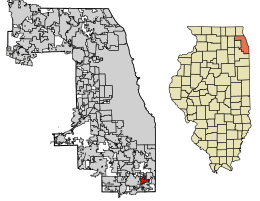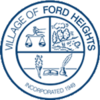Ford Heights, Illinois facts for kids
Quick facts for kids
Ford Heights, Illinois
|
|||
|---|---|---|---|
|
|||

Location of Ford Heights in Cook County, Illinois.
|
|||
| Country | |||
| State | Illinois | ||
| County | Cook | ||
| Township | Bloom | ||
| Incorporated | 1949 | ||
| Area | |||
| • Total | 1.95 sq mi (5.04 km2) | ||
| • Land | 1.95 sq mi (5.04 km2) | ||
| • Water | 0.00 sq mi (0.00 km2) 0% | ||
| Population
(2020)
|
|||
| • Total | 1,813 | ||
| • Density | 931.65/sq mi (359.65/km2) | ||
| Standard of living (2007–11) | |||
| • Per capita income | $12,217 | ||
| • Median home value | $80,200 | ||
| ZIP code(s) |
60411
|
||
| Area code(s) | 708 | ||
| Geocode | 26710 | ||
| FIPS code | 17-26710 | ||
Ford Heights is a small village in Cook County, Illinois, in the United States. It used to be called East Chicago Heights. In 2020, about 1,813 people lived there. Ford Heights is a suburb of Chicago. Many of the first people who settled here were African American. Since it became an official village in 1949, most of its residents have been Black. Over the years, the village has faced challenges, partly because there isn't much business activity.
Contents
Where is Ford Heights?
Ford Heights is located in Illinois, a state in the United States. It covers an area of about 1.95 square miles (5.04 square kilometers). The village is situated on the edge of a landform called the Tinley Moraine.
A Look at Ford Heights' History
The area that is now Ford Heights was first settled in the late 1840s. It was an important stop on the Underground Railroad. This was a secret network that helped enslaved people escape to freedom.
Early Community Life
By the early 1900s, the area became a farming community. Many Poles, Lithuanians, and Italians worked on these farms. After World War I, many African Americans from the Southern U.S. moved here. They also found work on the farms.
In the 1920s, a new neighborhood called "Park Addition" grew. It was built along a farm road that connected Chicago Heights to Indiana. In 1924, 40 families living there successfully asked for electricity. Soon after, the main road became a two-lane highway. It was named U.S. Route 30, which is part of the famous Lincoln Highway. By the 1930s, the Park Addition had telephone service. It became known as East Chicago Heights.
Becoming a Village
In the 1940s, a woman named Alberta Armstrong and others helped organize women in the community. They worked together to raise money for a new fire truck. By 1948, they formed the East Chicago Heights Citizens Association.
East Chicago Heights officially became a village in 1949. The first mayor was Charlie Williams. In 1950, the village had 1,548 residents. About 76.9% of them were Black.
Growth and Challenges
In 1956, the Ford Motor Company opened a large plant nearby. This plant offered good jobs to minorities. East Chicago Heights grew into a community of mostly middle-class Black families. At that time, they had limited choices for housing in other Chicago suburbs. The village's population more than doubled to 3,270 by 1960. This growth continued, and a popular new neighborhood called Sunnyfield opened in 1964.
Later in the 1960s, some older homes were replaced with new public housing. This brought more residents with lower incomes to the village. This put a strain on the village's resources. Ford Heights had limited businesses and a small tax base. The population grew to 5,000 in 1970 and reached its highest point of 5,347 in 1980.
In 1987, East Chicago Heights changed its name to Ford Heights. This was an attempt to include the Ford Stamping Plant area within the village. However, this effort was not successful. The land was eventually added to the nearby city of Chicago Heights.
Ford Heights has faced many difficulties over the years. These include challenges with its public services and a decrease in population. The Cook County Sheriff's Department took over local law enforcement duties in 2008. Between 1980 and 2020, the population of Ford Heights dropped by more than 66%.
Who Lives in Ford Heights?
Ford Heights has seen changes in its population over the years.
| Race / Ethnicity (NH = Non-Hispanic) | Pop 2000 | Pop 2010 | Pop 2020 | % 2000 | % 2010 | % 2020 |
|---|---|---|---|---|---|---|
| White alone (NH) | 47 | 40 | 44 | 1.36% | 1.45% | 2.43% |
| Black or African American alone (NH) | 3,296 | 2,635 | 1,651 | 95.37% | 95.37% | 91.06% |
| Native American or Alaska Native alone (NH) | 1 | 6 | 7 | 0.03% | 0.22% | 0.39% |
| Asian alone (NH) | 3 | 3 | 4 | 0.09% | 0.11% | 0.22% |
| Pacific Islander alone (NH) | 0 | 0 | 0 | 0.00% | 0.00% | 0.00% |
| Other race alone (NH) | 1 | 0 | 3 | 0.03% | 0.00% | 0.17% |
| Mixed race or Multiracial (NH) | 21 | 37 | 37 | 0.61% | 1.34% | 2.04% |
| Hispanic or Latino (any race) | 87 | 42 | 67 | 2.52% | 1.52% | 3.70% |
| Total | 3,456 | 2,763 | 1,813 | 100.00% | 100.00% | 100.00% |
In 2020, there were 1,813 people living in Ford Heights. Most residents, about 91.73%, were African American. About 2.81% were White, and 3.70% were Hispanic or Latino.
There were 885 households in the village. About 28.9% of these households had children under 18. The average household had about 4 people. The median age in the village was 39.0 years.
The median income for a household was $37,083. This means half of the households earned more than this, and half earned less. About 37.8% of the population lived below the poverty line. This included 66.2% of those under 18.
Learning in Ford Heights
Students in Ford Heights attend public schools run by two different districts.
- Ford Heights School District 169
- Medgar Evers Primary Academic Center (for grades PK-4)
- Cottage Grove Upper Grade Center (for grades 5-8)
- Bloom Township High School District 206
- High school students go to Bloom Trail High School.
Getting Around Ford Heights
Pace provides bus services in Ford Heights. Routes 357 and 358 connect the village to Chicago Heights. They also link to other places in the Southland area.
See also
 In Spanish: Ford Heights para niños
In Spanish: Ford Heights para niños






